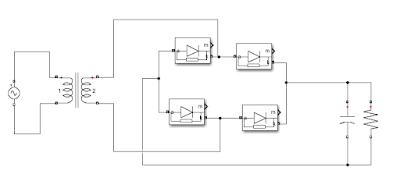.png) |
| Design and Simulation of a Bridge Rectifier Circuit Using MATLAB |
Welcome to the next installment in our series on rectifiers. In our previous posts, we explored half-wave rectifiers and center-tapped full-wave rectifiers. Now, we'll delve into the world of bridge rectifiers. A bridge rectifier is an essential component in electronics that efficiently converts alternating current (AC) into direct current (DC). In this blog post, we will walk you through the design and simulation of a bridge rectifier circuit using MATLAB.
Understanding Bridge Rectifiers
Before we jump into the practical aspects of bridge rectifiers, let's take a moment to understand what they are and why they matter.
Advantages of Bridge Rectifiers:
Bridge rectifiers offer several advantages over other rectifier types:
- They provide full-wave rectification, making use of both the positive and negative halves of the AC input waveform.
- Bridge rectifiers are highly efficient, making them suitable for a wide range of applications.
- They might not require a center-tapped transformer, simplifying their design.
The Diode Bridge:
At the heart of a bridge rectifier is a diode bridge, typically consisting of four diodes arranged in a specific configuration. These diodes work together to rectify the AC input.
Components of a Bridge Rectifier Circuit
To build a bridge rectifier circuit, you will need the following components:
- AC Voltage Source: Provides the input AC signal.
- Step-Down Transformer: Reduces the input AC voltage to the desired level
- Diode Bridge: Comprising four diodes arranged in a bridge configuration.
- Filtering Capacitor: Smoothens the rectified output.
- Load Resistor: Represents the device or load connected to the rectified output.
 |
| fig 1: bridge rectifier circuit |
How a Bridge Rectifier Works
From fig 1 above, a bridge rectifier with AC voltage step-down operates by using a transformer to reduce the input AC voltage, and then four diodes rectifier both the positive and negative halves of the AC input cycle. Here's is a step-by-step explanation of how it works:
- AC Input and Step-Down Transformer: The AC input voltage is connected to the step-down transformer, which reduces the voltage to the desired level.
- Output of the Transformer: The transformer output is connected to the diode bridge.
- Role of Diodes in Rectification: Depending on the polarity of the AC input, two diodes conduct at any given time. This allows current to flow in one direction only.
- Output Voltage Waveform: The result is a pulsating DC output voltage that effectively combines both halves of the AC input cycle.
- Filtering and Smoothing: To remove the ripples from the output, a filtering capacitor is added in parallel with the load resistor.
- Load Resistor and DC Output Voltage: The load resistor represents the device being powered. The voltage across the load resistor is the rectified and smoothed DC output voltage.
The image below shows the different output waveform from a bridge rectifier circuit shown in fig 1.
Practical Applications of Bridge Rectifiers
Bridge rectifiers find applications in various electronic circuits, including:
- Power Supplies: They are commonly used in power supply circuits for electronic devices.
- Battery Chargers: Bridge rectifiers are essential components in battery charging circuits.
- Audio Signal Rectification: In audio circuits, they are employed for signal rectification.
- DC Power Generation: When a stable DC voltage is needed from an AC source, bridge rectifiers are a popular choice.
Designing a Bridge Rectifier Circuit With AC Voltage Step-Down
Designing a bridge rectifier circuit with AC voltage step-down involves selecting a suitable transformer, choosing diodes, calculating the filtering capacitor's value, and selecting an appropriate load resistor. Here are the essential steps:
- Transformer Selection: Choose a transformer with the appropriate turns ratio to archived the desired voltage step-down.
- Diode Selection: Choose diodes that match the expected current and voltage requirements.
- Filtering Capacitor: Calculate the capacitor's value to achieve the desired output ripple voltage.
- Load Resistor: Select an appropriate load resistor based on the load's requirements and the desired output voltage.
Simulation of Bridge Rectifier Using MATLAB
Now, let's explore how to simulate a bridge rectifier circuit using MATLAB, a versatile tool for simulating and analyzing electronic circuits. Follow these steps:
- Setting up the MATLAB Environment: Launch MATLAB and create a new script or Simulink model.
- Building the Circuit Model: Define the circuit components, including the AC voltage source, transformer, diode bridge, filtering capacitor, and load resistor.
- Defining Parameters and Components: Specify the parameters for the AC source, transformer, diodes, capacitor, and load resistor. Set initial conditions as needed.
- Running the Simulation: Execute the simulation and observe the output waveforms.
- Analyzing and Visualizing the Results: Use MATLAB's analysis tools to examine the rectified output, including voltage and current waveforms.
Video Demonstration
For a visual guide on how to design and simulate a bridge rectifier circuit using MATLAB, watch the following video:
Conclusion
In this blog post, we've explored the world of bridge rectifiers, their advantages, and their applications in electronics. We've also provided a step-by-step guide to simulating a bridge rectifier circuit using MATLAB, a valuable tool for electronics enthusiasts and engineers.
Understanding and simulating electronic circuits like the bridge rectifier is essential for anyone working in electronics or related fields. We hope this guide has been informative and helpful in your journey to mastering electronics.
Additional Resources
- [Link to MATLAB's official documentation]
- [Link to our MATLAB Simulink tutorials]
- [Link to our video collection on MATLAB simulation]
Comments and Discussion
We encourage you to share your thoughts, questions, or experiences in the comments section of our social media handle. Feel free to ask for clarifications or share your own insights with the community.





.png)
.png)